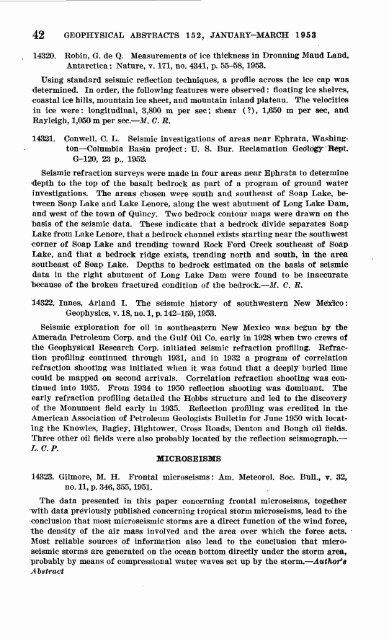Geophysical Abstracts 152 January-March 1953
Geophysical Abstracts 152 January-March 1953
Geophysical Abstracts 152 January-March 1953
Create successful ePaper yourself
Turn your PDF publications into a flip-book with our unique Google optimized e-Paper software.
42 GEOPHYSICAL ABSTRACTS <strong>152</strong>, JANUARY-MARCH <strong>1953</strong><br />
14320. Robin, G. de Q. Measurements of ice thickness in Dronning Maud Land,<br />
Antarctica: Nature, v. 171, no. 4341, p. 55-58, <strong>1953</strong>.<br />
Using standard seismic reflection techniques, a profile across the ice cap was<br />
determined. In order, the following features were observed: floating ice shelves,<br />
coastal ice hills, mountain ice sheet, and mountain inland plateau. The velocities<br />
in ice were: longitudinal, 3,800 m per sec; shear (?), 1,650 m per sec, and<br />
Rayleigh, 1,050 m per sec. M. C. R.<br />
14321. Con well, C. L. Seismic investigations of areas near Bphrata, Washing<br />
ton Columbia Basin project: U. S. Bur. Reclamation Geology Rept.<br />
G-120, 23 p., 1952;<br />
Seismic refraction surveys were made in four areas near Bphrata to determine<br />
depth to the top of the basalt bedrock as part of a program of ground water<br />
investigations. The areas chosen were south and southeast of Soap Lake, be<br />
tween Soap Lake and Lake Lenore, along the west abutment of Long Lake Dam,<br />
and west of the town of Quincy. Two bedrock contour maps were drawn on the<br />
basis of the seismic data. These indicate that a bedrock divide separates Soap<br />
Lake from Lake Lenore, that a .bedrock channel exists starting near the southwest<br />
corner of Soap Lake and trending toward Rock Ford Creek southeast of Soap<br />
Lake, and that a bedrock ridge exists, trending north and south, in the area<br />
southeast of Soap Lake. Depths to bedrock estimated on the basis of seismic<br />
data in the right abutment of Long Lake Dam were found to be inaccurate<br />
"because of the broken fractured condition of the bedrock. M. C. R.<br />
14322. Innes, Arland I. The seismic history of southwestern New Mexico:<br />
Geophysics, v. 18, no. 1, p. 142-159,<strong>1953</strong>.<br />
Seismic exploration for oil in southeastern New Mexico was begun by the<br />
Amerada Petroleum Corp. and the Gulf Oil Co. early in 1928 when two crews of<br />
the <strong>Geophysical</strong> Research Corp. initiated seismic refraction profiling. Refrac<br />
tion profiling continued through 1931, and in 1932 a program of correlation<br />
refraction shooting was initiated when it was found that a deeply buried lime<br />
could be mapped on second arrivals. Correlation refraction shooting was con<br />
tinued into 1935. From 1934 to 1950 reflection shooting was dominant. The<br />
early refraction profiling detailed the Hobbs structure and led to the discovery<br />
of the Monument field early in 1935. Reflection profiling was credited in the<br />
American Association of Petroleum Geologists Bulletin for June 1950 with locat<br />
ing the Knowles, Bagley, Hightower, Cross Roads, Denton and Bough oil fields.<br />
Three other oil fields were also probably located by the reflection seismograph.<br />
L. C. P.<br />
MICROSEISMS<br />
14323. Gilmore, M. H. Frontal microseisms: Am. Meteorol. Soc. Bull., v. 32,<br />
no. 11, p. 346,355,1951.<br />
The data presented in this paper concerning frontal microseisms, together<br />
with data previously published concerning tropical storm microseisms, lead to the<br />
conclusion that most microseisrnic storms are a direct function of the wind force,<br />
the density of the air mass involved and the area over which the force acts.<br />
Most reliable sources of information also lead to the conclusion that micro-<br />
seismic storms are generated on the ocean bottom directly under the storm area,<br />
probably by means of compression al water waves set up by the storm. Author's<br />
A ~bstra.ct

















